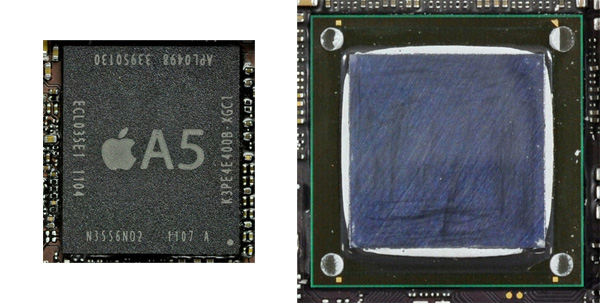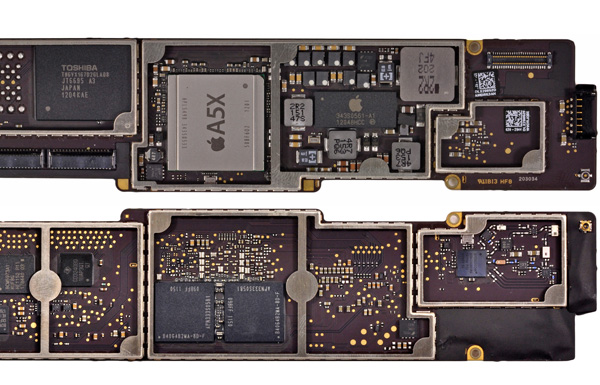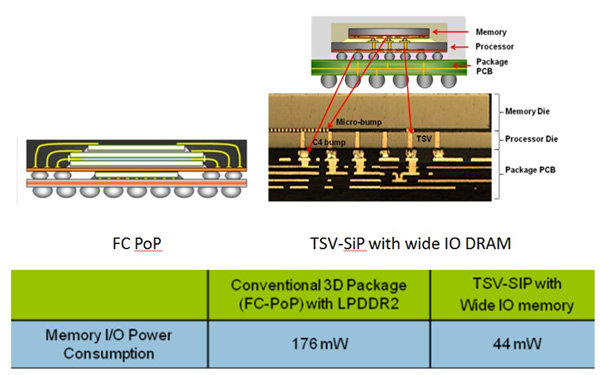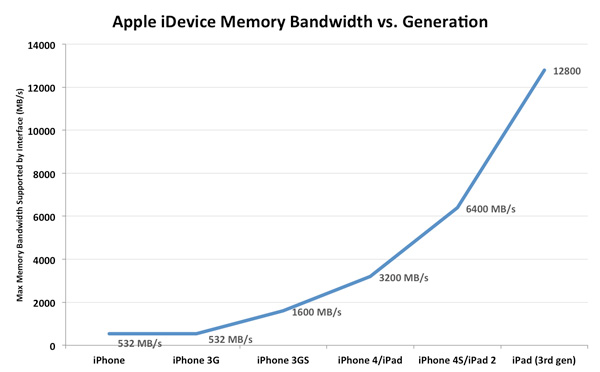The Apple iPad Review (2012)
by Vivek Gowri & Anand Lal Shimpi on March 28, 2012 3:14 PM ESTA Word on Packaging
Unlike the first two iPads, the 3rd generation iPad abandons the high density flip-chip PoP SoC/DRAM stack and uses a discrete, flip-chip BGA package for the SoC and two discrete BGA packages for the DRAMs.
If you think of SoC silicon as a stack, the lowest layer is where you'll find the actual transistor logic, while the layers of metal above it connect everything together. In the old days, the silicon stack would sit just as I've described it—logic at the bottom, metal layers on top. Pads around the perimeter of the top of the silicon would connect to very thin wires, that would then route to the package substrate and eventually out to balls or pins on the underside of the package. These wire bonded packages, as they were called, had lower limits of how many pins you could have connecting to your chip.
There are also cooling concerns. In a traditional wire bonded package, your cooling solution ultimately rests on a piece of your packaging substrate. The actual silicon itself isn't exposed.
As its name implies, a flip-chip package is literally the inverse of this. Instead of the metal layers being at the top of the stack, before packaging the silicon is inverted and the metal layers are at the bottom of the stack. Solder bumps at the top of the silicon stack (now flipped and at the bottom) connect the topmost metal layer to the package itself. Since we're dealing with solder bumps on the silicon itself rather than wires routed to the edge of the silicon, there's much more surface area for signals to get in/out of the silicon.
Since the chip is flipped, the active logic is now exposed in a flip-chip package and the hottest part of the silicon can be directly attached to a cooling solution.

An example of a PoP stack
To save on PCB real estate however, many SoC vendors would take a flip-chip SoC and stack DRAM on top of it in a package-on-package (PoP) configuration. Ultimately this re-introduces many of the problems from older packaging techniques—mainly it becomes difficult to have super wide memory interfaces as your ball-out for the PoP stack is limited to the area around your die, and cooling is a concern once more. For low power, low bandwidth mobile SoCs this hasn't really been a problem, which is why we see PoP stacks deployed all over the place.
Take a look at the A5, a traditional FC-BGA SoC with PoP DRAM vs. the A5X (this isn't to scale):

Images courtesy iFixit
The A5X in this case is a FC-BGA SoC but without any DRAM stacked on top of it. The A5X is instead covered in a thermally conductive paste and then with a metallic heatspreader to conduct heat away from the SoC and protect the silicon.
Given the size and complexity of the A5X SoC, it's no surprise that Apple didn't want to insulate the silicon with a stack of DRAM on top of it. In typical package-on-package stacks, you'd see solder bumps around the silicon, on the package itself, that a separate DRAM package would adhere to. Instead of building up a PoP stack here, Apple simply located its two 64-bit DRAM devices on the opposite side of the iPad's logic board and routed the four 32-bit LP-DDR2 memory channels through the PCB layers.

iPad (3rd gen) logic board back (top) and front (bottom), courtesy iFixit
If I'm seeing this correctly, it looks like the DRAM devices are shifted lower than the center point of the A5X. Routing high speed parallel interfaces isn't easy and getting the DRAM as close to the memory controller as possible makes a lot of sense. For years motherboard manufacturers and chipset vendors alike complained about the difficulties of routing a high-speed, 128-bit parallel DRAM interface on a (huge, by comparison) ATX motherboard. What Apple and its partners have achieved here is impressive when you consider that this type of interface only made it to PCs within the past decade.
Looking Forward: 12.8GB/s, the Magical Number
The DRAM speeds in the new iPad haven't changed. The -8D in the Elpida DRAM string tells us this memory is rated at the same 800MHz datarate as what's used in the iPhone 4S and iPad 2. With twice the number of channels to transfer data over however, the total available bandwidth (at least to the GPU) doubles. I brought back the graph I made for our iPhone 4S review to show just how things have improved:
The A5X's memory interface is capable of sending/receiving data at up to 12.8GB/s. While this is still no where near the 100GB/s+ we need for desktop quality graphics at Retina Display resolutions, it's absolutely insane for a mobile SoC. Bandwidth utilization is another story entirely—we have no idea how good Apple's memory controller is (it is designed in-house), but there's 4x the theoretical bandwidth available to the A5X as there is to NVIDIA's Tegra 3.
There's a ton of memory bandwidth here, but Apple got to this point by building a huge, very power hungry SoC. Too power hungry for use in a smartphone. As I mentioned at the start of this article, the SoC alone in the new iPad can consume more power than the entire iPhone 4S (e.g. A5X running Infinity Blade 2 vs. iPhone 4S loading a web page):
| Power Consumption Comparison | ||||
| Apple A5X (SoC + mem interface) | Apple iPhone 4S (entire device) | |||
| Estimated Power Consumption | 2.6W—Infinity Blade 2 | 1.6W—Web Page Loading | ||
There's no question that we need this much (and more) memory bandwidth, but the A5X's route to delivering it is too costly from a standpoint of power. There is a solution to this problem however: Wide IO DRAM.
Instead of using wires to connect DRAM to solder balls on a package that's then stacked on top of your SoC package, Wide IO DRAM uses through-silicon-vias (TSVs) to connect a DRAM die directly to the SoC die. It's an even more costly packaging technique, but the benefits are huge.

Just as we saw in our discussion of flip-chip vs. wire bonded packages, conventional PoP solutions have limits to how many IO pins you can have in the stack. If you can use the entire silicon surface for direct IO however, you can build some very wide interfaces. It also turns out that these through silicon interfaces are extremely power efficient.
The first Wide IO DRAM spec calls for a 512-bit, 200MHz SDR (single data rate) interface delivering an aggregate of 12.8GB/s of bandwidth. The bandwidth comes at much lower power consumption, while delivering all of the integration benefits of a traditional PoP stack. There are still cooling concerns, but for lower wattage chips they are less worrisome.
Intel originally predicted that by 2015 we'd see 3D die stacking using through-silicon-vias. Qualcomm's roadmaps project usage of TSVs by 2015 as well. The iPhone won't need this much bandwidth in its next generation thanks to a lower resolution display, but when the time comes, there will be a much lower power solution available thanks to Wide IO DRAM.
Oh and 2015 appears to be a very conservative estimate. I'm expecting to see the first Wide IO memory controllers implemented long before then...











234 Comments
View All Comments
Steelbom - Thursday, March 29, 2012 - link
I'm curious why we didn't see any graphics benchmarks from the UDK like with the iPhone 4S review?Craig234 - Thursday, March 29, 2012 - link
Wow, this is good to buy... 'if you are in desperate need for a tablet'?That's a pretty weak recommendation, I expected a much stronger endorsement based on the review.
Chaki Shante - Friday, March 30, 2012 - link
Great, thorough review, thanks Anand et al.Given the sheer size of the SoC (like 4x larger then Tegra2 or OMAP4430, and 2x Tegra3), you'd bet Apple has the fastest current SoC, at least GPU-wise.
This SoC is just huge and Apple's margin is certainly lowered. Is this sustainable on the long run ?
I wonder if any other silicon manufacturer could make same size devices (not technologically but from a price perspective) and expect to sell them.
dagamer34 - Friday, March 30, 2012 - link
No one else needs to crank out so many chips that are the same. Also, other companies will be waiting long enough to use 28nm, so there's little chance they'll be hitting the same size as the A5X on 45nm.Aenean144 - Friday, March 30, 2012 - link
Since Apple is both the chip designer/licensee and hardware vendor, it saves them the cost of paying a middleman. Ie, Nvidia has to make a profit on a Tegra sale, Apple does not, and can afford a more expensive chip from the fab compared to the business component chain from Asus to Nvidia to GF/TSMC and other IP licensees.I bet there is at least 50% margin somewhere in the transaction chain from Asus to Nvidia to GF/TSMC. Apple may also have a sweetheart IP deal from both ARMH and IMGTEC that competitors may not have.
shompa - Friday, March 30, 2012 - link
@Aenean144Tegra2 cost 25 dollars for OEMs and 15 dollars to manufacture. A5 cost Apple 25 dollars to manufacture. By designing its own SoC Apple got 30% larger SoC at the same price as Android OEMs.
Tegra3 is huge. That is a problem for Nvidia. It costs at least 50% more to manufacture. Nvidia is rumored to charge 50 dollar for the SoC.
A5X is 50%+ larger then Tegra3. Depending of yields it cost Apple 35-50 dollar per SoC.
The integrated model gives Apple cheaper SoCs, but also custom designed for their needs. Apple have a long history of Accelerating stuff in its OS. Back in 2002 it was AltiVec. Encoding a DVD on a 667mhz powerbook took 90 minutes. The fastest X86 AMD 1.5ghz it took 15 hours. (and it was almost impossible to have XP not bluescreen for 15 hours under full load). Since 2002 Apple accelerate OSX with Quarz Extreme. Both these techniques are now used in iOS with SIMD acceleration and GPU acceleration. Its much more elegant then the brute force X86 approach. Integrated makes it possible to use slower, cheaper and more efficient designs.
shompa - Friday, March 30, 2012 - link
The A5X SoC is a disaster. Its a desperation SoC that had to be implemented when TSMC 28nm process slipped almost 2 years. That is the reason why Apple did not tape out a 32nm A5X on Samsung. PA Semi had to crank out a new tapeout fast with existing assets. So they took the A5 and added 2 more graphics core.The real A6 SoC is probably ready since long back, but TSMC cant deliver enough wafers. The rumored tapeout for A6 was mid 2011. Apple got test wafers from TSMC in june and another batch of test wafers in october. Still at this point Apple believed they would use TSMC for Ipad3.
ARM is about small, cheap and low power SoCs. That is the future of computing. The A5X is larger then many X86 chips. Technically Intel manufactures many of its CPUs cheaper then Apple manufactures the A5X SoC. That is insane.
stimudent - Friday, March 30, 2012 - link
Products reviews are fun to look at, but where there's a bright side, there is always a dark side. Maybe product scoring should also reflect how a manufacturer treats its employees.name99 - Friday, March 30, 2012 - link
You mean offers them a better wage than they could find in the rest of China, and living conditions substantially superior to anywhere else they could work?Yes, by all means let's use that scoring.
Or perhaps you'd like to continue to live your Mike Daisey dystopia because god-forbid that the world doesn't conform to your expectations?
Craig234 - Friday, March 30, 2012 - link
I'm all for including 'how a company treats its employees' and other social issues; but I'd list them separately, not put them in a product rating.